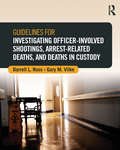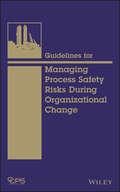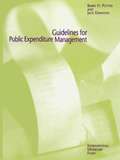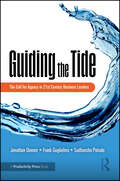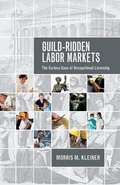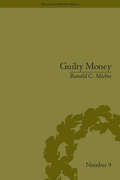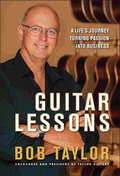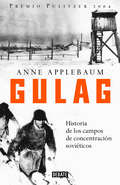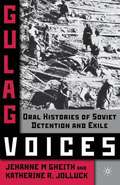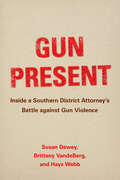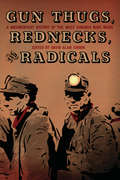- Table View
- List View
Guidelines for Fiscal Adjustment
by International Monetary FundA report from the International Monetary Fund.
Guidelines for Foreign Exchange Reserve Management
by International Monetary FundA report from the International Monetary Fund.
Guidelines for Green Mine Construction and Management
by Liang Wang Yong Wang Suping PengThis book comprehensively covers many aspects of green mine, including the basic situation of green mines, mine facilities, extraction management, ecological environment, scientific and technological innovation, standardized management, environmental protection inspectors, and special tools in response to the needs of green mine construction, assessment, and management. It is highly informative with valuable techniques and tools providing insights both for scholars and practitioners working in green mine field.
Guidelines for Implementing an HR Scorecard
by Dave Ulrich Brian E. Becker Mark A. HuselidWhat are the challenges involved in implementing a strategically focused HR architecture and HR Scorecard? The authors provide a seven-step model for planning and evaluating the change management activities associated with implementation efforts. From the early stages of deciding who should lead change in your organization, to the key final stages of ensuring that change will last, this chapter explains how to build the acceptance element of your HR Scorecard, guiding you through the implementation process.
Guidelines for Investigating Officer-Involved Shootings, Arrest-Related Deaths, and Deaths in Custody (Routledge Series on Practical and Evidence-Based Policing)
by Darrell L. Ross Gary M. VilkeAs unrest over officer-involved shootings and deaths in custody takes center stage in conversations about policing and the criminal justice system, Guidelines for Investigating Officer-Involved Shootings, Arrest-Related Deaths, and Deaths in Custody addresses critical investigation components from an expert witness perspective, providing the insights necessary to ensure a complete investigation. Investigating a custodial death or an officer involved in a shooting presents unique and complex issues: estate, community, judicial, agency, involved officer, and public policy interests are all at stake. These types of deaths present various emerging medical, psychological, legal and liability, technical, and investigatory issues that must be addressed through a comprehensive investigation. This book is ideal for students in criminal investigation, death investigation, crime scene investigation, and special topic courses in custodial deaths and officer-involved shootings, as well as for death investigators, law enforcement officers, police administrators, and attorneys.
Guidelines for Managing Process Safety Risks During Organizational Change, 1st Edition
by CcpsAn understanding of organizational change management (OCM) -- an often overlooked subject -- is essential for successful corporate decision making with little adverse effect on the health and safety of employees or the surrounding community. Addressing the myriad of issues involved, this book helps companies bring their OCM systems to the same degree of maturity as other process safety management systems. Topics include corporate standard for organizational change management, modification of working conditions, personnel turnover, task allocation changes, organizational hierarchy changes, and organizational policy changes.
Guidelines for Public Debt Management
by International Monetary FundA report from the International Monetary Fund.
Guidelines for Public Expenditure Management
by Jack Diamond Barry H. PotterFor many years, the IMF's Public Expenditure Management Division has answered many questions raised by fiscal economists on missions. Based on this experience, these guidelines provide a general overview of the principles and practices observed in three key aspects of public expenditure management: budget preparation, budget execution, and cash planning. For each aspect the guidelines look at the differing practices in four groups of countries: the francophone system, the Commonwealth systems, Latin America, and those in the transition economies.
Guiding Professional Accountants to Do The Right Thing
by Paul M. Healy Penelope Rossano V. G. NarayananCase
Guiding Your Brightest Stars: The Three-Hat Challenge
by Jay W. Lorsch Thomas J. TierneyPartner level stars are a professional service firm's scarcest and most valuable resource. Whether the firm succeeds or fails depends on their performance and leadership, and ultimately on the alignment of their goals with the firm's goals. This chapter discusses how great firms guide and motivate their senior stars.
Guiding Your Flight Progress: The Power of Dashboards--Building a Better Business Model Through Trial and Error
by Randy Komisar John MullinsAs entrepreneurs, many of our assumptions and initial plans are shaped by the examples of companies and business models that came before. But what happens when these analogs reach the limit of what they can tell us? A leap of faith is required, driven by a burning question that cannot be answered without some real-world data. Once hypotheses have been formed, we need to test them as quickly and cheaply as possible to measure the results of our risks. In this chapter, the authors outline the process of dashboarding--keeping a systematic record of your hypotheses and their results. Dashboarding will allow you to constantly test your assumptions at every stage of your journey from Plan A to a Plan B or C or Z that will deliver you the kind of success you seek. This chapter demonstrates the importance of this iterative process using the inspiring cases of GlobalGiving and Aggregate Knowledge. This chapter was originally published as Chapter 2 of "Getting to Plan B: Breaking Through to a Better Business Model."
Guiding the Tide: The Call for Agency in 21st Century Business Leaders
by Jonathan Donner Sudhanshu Palsule Frank GuglielmoIn a world increasingly driven by artificial intelligence, leadership needs to move beyond the "agile" approach that dominated organizational leadership practices at the end of the 20th century. What is required now for successful leaders is a skillful juxtaposition of proactivity and humility, which we call "guiding the tide." Successful leaders of today must demonstrate personal agency in order to guide the tide of events around them rather than have the tide of events sweep them along. The "tide," like a river within an ocean akin to a gulf stream, is a unique, ever-changing stream of business systems, technology, consumers, and competitors. This book uses storytelling, examples, and clear, everyday language to blend leading-edge psychological research and leadership practices with the authors’ own work in coaching, assessing, and developing leaders for three decades around the world. The book takes the reader on a journey through three major learnings: First, the authors describe the nature of the tide and the demands on leaders to move beyond a reactionary, agile approach toward the forward-leaning, active stance of personal agency. Second, they describe three critical practices to successfully lead with agency and guide the tide: Honest Engagement – the practice of dealing with others from a place of openness, honesty, and a willingness to be vulnerable. Addressing Reality – the practice of seeing the world as it is rather than as we wish it to be, the ability to separate fact from fiction and data from desire. Adaptive Impact – the practice of driving the organization, team, and oneself forward in a way that creates results-beyond- results, that is, delivering goals while building followership, sustainability and "Humanocity" – the integration of human creativity and judgment with the efficiency of digital automation. Third, they offer leaders a practical path to achieving the personal agency to successfully guide their organization through the tide that shapes their world.
Guild Education: Unlocking Opportunity for America's Workforce
by William A. Sahlman Michael D. Smith Nicole Tempest Keller Alpana ThaparFounded in 2015, Guild Education is an education marketplace that connects employers and universities to provide employees with 'education as a benefit.' The Denver-based company is transforming traditional tuition assistance programs by facilitating direct payment by the employer to the academic institution and by supporting students with coaching and advising. By October 2020, Guild had gained market traction and demonstrated impressive results. Rachel Carlson, CEO and cofounder of Guild, must decide how to manage the company's future growth. She believes there is great potential within its core education marketplace to expand the network of academic institutions and portfolio of company partners. Carlson also envisions extending the business model and entering the career placement market. To successfully do that, she needs to find the same incentive alignment in these new businesses as in Guild's core education platform. Would it be possible to find a solution that would result in a win-win outcome for all?
Guild-ridden Labor Markets: The Curious Case of Occupational Licensing
by Morris M. Kleiner"In his third Upjohn Press book on occupational licensing, Morris M. Kleiner examines why the institution of occupational licensing has had such a curious evolution and influence in the United States, the European Union, and China. He also discusses the many similarities it has to guilds."--Publisher's website.
Guilty Money: The City of London in Victorian and Edwardian Culture, 1815-1914 (Financial History #9)
by Ranald C MichieThis is an engaging study of the place occupied by the City of London within British cultural life during the Victorian and Edwardian periods. Michie uses both literary and popular novels to examine socio-economic representations during this period.
Guinea: Poverty Reduction Strategy Second Annual Progress Report
by International Monetary FundA report from the International Monetary Fund.
Guinea: Selected Issues and Statistical Appendix
by International Monetary FundA report from the International Monetary Fund.
Guinness
by Bill YenneA perfectly poured history of the world's greatest beer. "Joseph Conrad was wrong. The real journey into the Heart of Darkness is recounted within the pages of Bill Yenne's fine book. Guinness (the beer) is a touchstone for brewers and beer lovers the world over. Guinness (the book) gives beer enthusiasts all the information and education necessary to take beer culture out of the clutches of light lagers and back into the dark ages. Cheers!" -Sam Calagione, owner, Dogfish Head Craft Brewery and author of Brewing Up a Business, Extreme Brewing, and Beer or Wine? "Marvelous! As Bill Yenne embarks on his epic quest for the perfect pint, he takes us along on a magical tour into the depths of all things Guinness. Interweaving the tales of the world's greatest beer and the nation that spawned it, Yenne introduces us to a cast of characters worthy of a dozen novels, a brewery literally dripping with history, and-of course-the one-and-only way to properly pour a pint. You can taste the stout porter on every page. " -Dan Roam, author of The Back of the Napkin: Solving Problems and Selling Ideas with Pictures
Guitar Lessons
by Bob TaylorThe inside story of the founding and growth of Taylor Guitars, one of the world's most successful guitar manufacturersBob Taylor mixes the details of his experience as a tradesman and cofounder of Taylor Guitars, a world-famous acoustic and electric guitar manufacturer, with philosophical life lessons that have practical application for building a business. From the "a-ha" moment in junior high school that inspired his very first guitar, Taylor has been living the American dream, crafting quality products with his own hands and building a successful, sustainable business. In Guitar Lessons, he shares the values that he lives by and that have provided the foundation for the company's success. Be inspired by a story of guts and gumption, an unwavering commitment to quality, and the hard lessons that made Taylor Guitars the company it is today.
Gulag
by Anne ApplebaumEl Gulag aparece en la conciencia de occidente en 1977 con la publicación de la obra de Aleksandr Solzhenitsin Archipiélago GULAG. A partir de nuevos estudios, memorias publicadas tras la caída de la URSS y algunos archivos hasta ahora secretos, Anne Applebaum realiza una reconstrucción histórica del origen y la evolución de los campos de concentración soviéticos que devuelve este infausto e inolvidable episodio al centro de la tormentosa historia del convulso siglo XX. Con detalle y precisión asistimos a la vida cotidiana en el campo: las automutilaciones para evitar los trabajos forzados, las bodas entre prisioneros, la vida de las mujeres y los niños, las rebeliones y los intentos de fuga. El libro, documentado y riguroso, sostiene que el Gulag nació no solo por la necesidad de aislar a los elementos que el Partido Comunista consideraba enemigos, sino para conseguir, al mismo tiempo, una masa de trabajadores-esclavos que trabajara a cambio de comida en inmensos proyectos como el canal del mar Blanco o las minas de Kolimá. Tras la descripción del horror organizado por el régimen soviético, el libro narra cómo Gorbachov, cuya familia se vio directamente afectada por esta política represiva, decidió terminar con este régimen carcelario liberando a la ciudadanía de uno de los más perversos y crueles sistemas represivos que el mundo ha conocido. «El Gulag de Anne Applebaum es un libro importante. Sus muchos años de minuciosa investigación han provisto a la autora de un inmenso caudal de fascinantes detalles para recrear una terrible e inolvidable historia.» ANTHONY BEEVOR, autor de Stalingrado
Gulag Voices
by Jehanne M Gheith Katherine R. JolluckIn this volume, the powerful voices of Gulag survivors become accessible to English-speaking audiences for the first time through oral histories, rather than written memoirs. It brings together interviews with men and women, members of the working class and intelligentsia, people who live in the major cities and those from the "provinces," and from an array of corrective hard labor camps and prisons across the former Soviet Union. Its aims are threefold: 1) to give a sense of the range of the Gulag experience and its consequences for Russian society; 2) to make the Gulag relevant to English-speaking readers by offering comparisons to historical catastrophes they are likely to know more about, such as the Holocaust; and 3) to discuss issues of oral history and memory in the cultural context of Soviet and post-Soviet society.
Gulf Oil Corp.--Takeover
by Kevin F. RockGulf Oil was pressured into liquidation while under attack by Boone Pickens of Mesa Petroleum Co. Gulf management was unsure whether to sell out or take the firm private. A suitor, Standard Oil of California, tries to decide how much, if anything, to bid for the privilege of owning Gulf.
Gun Present: Inside a Southern District Attorney's Battle against Gun Violence
by Susan DeweyGun Present takes us inside the everyday operations of the law at a courthouse in the Deep South. Illuminating the challenges accompanying the prosecution of criminal cases involving guns, the three coauthors—an anthropologist, a geographer, and a district attorney—present a deeply human portrait of prosecutors’ work. Built on an immersive, community-based participatory partnership between researchers and criminal justice professionals, Gun Present chronicles how a justice assemblage comprising institutional structures and practices, relationships and roles, and individual moral and emotional worlds informs the day-to-day administration of justice. Weaving together in-depth interviews, quantitative analysis of more than a thousand criminal cases, analysis of trial transcripts, and over a year of ethnographic observations, Gun Present provides a model for scholar-practitioner collaborations.
Gun Safety in America: Three Leaders Propose Innovative Solutions
by Rosabeth Moss Kanter Joseph A. PaulGun violence was a significant problem in America. Three Harvard Advanced Leadership Initiative Fellows Christy Wood, Russell Sternlicht, and Gareth Glaser each decided to do something about gun safety. They each used their professional and leadership experience to identify their own solutions to the issue. Wood created a set of principles for investments funds to pressure gun manufacturers and gun sellers within their portfolios to adopt safety standards. Sternlicht designed a membership-based lobbying and advocacy group in order to harness the power of mass movements to create positive change. And Glaser founded a smart-gun company whose product could help reduce certain types of deaths and injuries. Would any of these three innovations move beyond the historical gridlock on gun safety?
Gun Thugs, Rednecks, and Radicals: A Documentary History of the West Virginia Mine Wars
by David Alan CorbinTelling the powerful story of the West Virginia coal mining rebellions of the early 20th century, this book collects material from the leaders, the miners, and the journalists sent to report on the 1912 and 1921 West Virginia mine wars—explosive examples of strikes and union battles. Featured in the text are articles, speeches, and discussions between union leaders such as Samuel Gompers, Frank Keeney, Fred Mooney, Bill Blizzard, and Mother Jones. Also included are U.S. Senate committee testimonies from miners and their family members describing life and work in the coal camps and explaining their participation in the violence. These facts clearly portray the human cost of industry and present the hard choices of a rebellious and often politically radical populace who refuses to be beleaguered under any circumstances.


